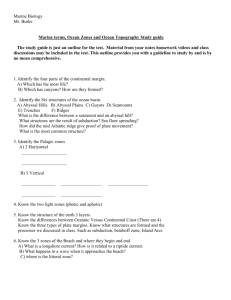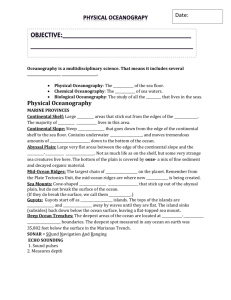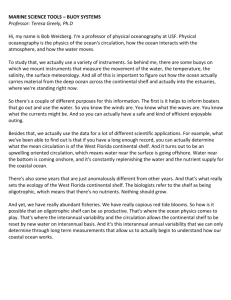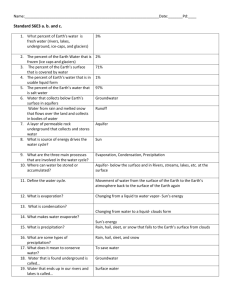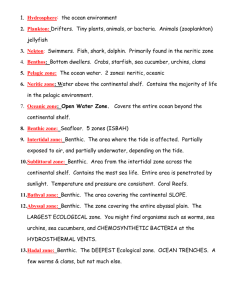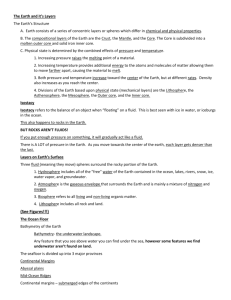Ocean Model Pre
advertisement
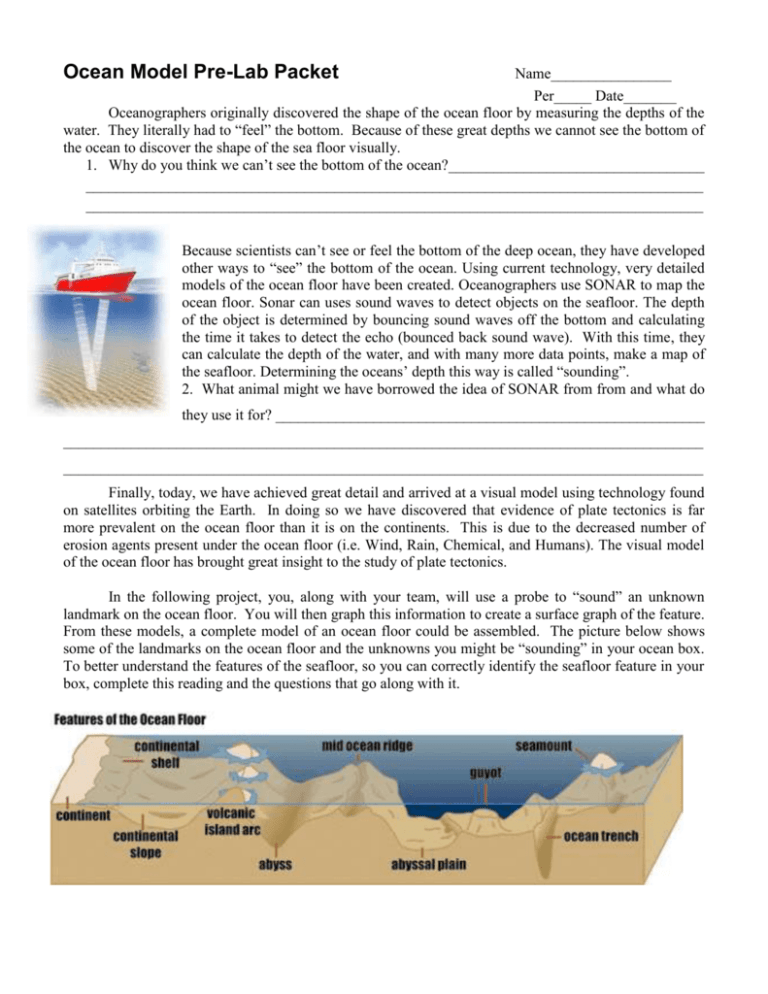
Ocean Model Pre-Lab Packet Name________________ Per_____ Date_______ Oceanographers originally discovered the shape of the ocean floor by measuring the depths of the water. They literally had to “feel” the bottom. Because of these great depths we cannot see the bottom of the ocean to discover the shape of the sea floor visually. 1. Why do you think we can’t see the bottom of the ocean?__________________________________ __________________________________________________________________________________ __________________________________________________________________________________ _ Because scientists can’t see or feel the bottom of the deep ocean, they have developed other ways to “see” the bottom of the ocean. Using current technology, very detailed models of the ocean floor have been created. Oceanographers use SONAR to map the ocean floor. Sonar can uses sound waves to detect objects on the seafloor. The depth of the object is determined by bouncing sound waves off the bottom and calculating the time it takes to detect the echo (bounced back sound wave). With this time, they can calculate the depth of the water, and with many more data points, make a map of the seafloor. Determining the oceans’ depth this way is called “sounding”. 2. What animal might we have borrowed the idea of SONAR from from and what do they use it for? _________________________________________________________ _____________________________________________________________________________________ _____________________________________________________________________________________ Finally, today, we have achieved great detail and arrived at a visual model using technology found on satellites orbiting the Earth. In doing so we have discovered that evidence of plate tectonics is far more prevalent on the ocean floor than it is on the continents. This is due to the decreased number of erosion agents present under the ocean floor (i.e. Wind, Rain, Chemical, and Humans). The visual model of the ocean floor has brought great insight to the study of plate tectonics. In the following project, you, along with your team, will use a probe to “sound” an unknown landmark on the ocean floor. You will then graph this information to create a surface graph of the feature. From these models, a complete model of an ocean floor could be assembled. The picture below shows some of the landmarks on the ocean floor and the unknowns you might be “sounding” in your ocean box. To better understand the features of the seafloor, so you can correctly identify the seafloor feature in your box, complete this reading and the questions that go along with it. Continental Shelf: The continental shelves are found on most of the Earth’s coasts. The continental shelves slope gently away from the shore to a depth of about 200 meters (650 feet). This structure is one that is not formed due to tectonic activity. In fact, rivers build the continental shelf. As time passed, rivers washed great loads of gravel, sand and silt onto the shoulders of the continental blocks. This sediment piles up, creating the continental shelf. Off many coasts, especially on the Atlantic, the shelf is wide, projecting more than 100 miles into the sea. The widest shelf anywhere, stretches 800 miles into the sea off the Atlantic shore of Siberia. There is almost no shelf off southeastern Florida. Off Florida, the Gulf Stream current runs like a swift underwater river, sweeping the offshore sea bottom clean of shelf-building debris. Off mountainous shores like the pacific coast of the American continents, there are a few rivers to pile up much sediment. Consequently, the continental shelf is narrow or nonexistent. 3. On the figure below, draw the continental shelves of North America for the Pacific Ocean and Atlantic Ocean Shores as well as the Florida Shores. Use the reading to help you. Siberia is not shown. Continental Slope: At the outer edge of the continental shelves, the land plunges down. This is often where the continental crust changes to oceanic crust. The slopes sometimes fall unbroken for two to three miles. These continental slopes are among the most imposing features of the entire earth. They are the highest and longest walls in the world. Nearly everywhere that oceanographers have mapped the continental slope so far, they have found deep gorges and canyons cut into its face. The force that had carved them was a mystery. Many were too far off shore, and in water too deep, to be explained as drowned riverbeds. Earthquakes had clearly opened a few but not all of these gorges. Scientists now believe they were cut into the continental slopes by powerful underwater avalanches called turbidity currents. These are currents of silt-laden, highdensity water that flow down the slopes. The water flows downward because it has a higher density than surrounding seawater. An earthquake or load of sediment on the continental shelf can send silt rushing down the slope. The silt, flowing at express-train speed, gouges out a canyon due to frictional forces as it goes. Turbidity currents can roll on for hundreds of miles. As they slow down, they spread out thick new layers of sediment. These layers of sediment form the abyssal plain. 4. Label the features on the diagram to the right: (a) continental slope (b) deep-ocean basin or abyss (c) continental shelf 5. a. What is a turbidity current? ____________ _______________________________________ _______________________________________ _______________________________________ _______________________________________ b. How do turbidity currents shape the continental slope? ____________________________________ _____________________________________________________________________________________ c. On the picture directly above, circle and label two places where turbidity currents are likely to have occurred. Also label the continental shelf, continental slope, and abyssal plain. The Deep-Ocean Basin or Floor: The deep ocean floor begins at the foot (bottom) of the continental slope. It is the biggest of the ocean’s three geographic domains, comprising over 70% of the total sea area. In this domain of darkness, man has made his most startling discoveries about the earth’s hidden surfaces. The flat sections of the deep-ocean floor turned out to be flatter than anything ever seen on land. Called abyssal plains, these level expanses lie as smooth and even as a dance floor. Core samples from these abyssal plains show that sediments from turbidity currents formed them. After carving canyons in the continental slope, the turbidity currents spread out when they reached the sea floor. Sediments carried by the currents gently filled every seabed crevice with sand, mud and silt washed down from the coasts. Amazingly enough, the ocean floor isn’t just flat. There are peaks, cones, ridges and cliffs that have formed beneath the sea. Many of these have been preserved largely unchanged because there is no wind, rain, and frost to wear away these features. On the Pacific floor, for example, there is a cliff that is one half a mile to one mile high and 3,000 miles long. It is as sharp and jagged, as if it had been formed yesterday. In spite of its appearances, the seafloor is 70 million years old in places and almost unchanged. 6. How are the submarine ridges and other features preserved unchanged? _________________________ _____________________________________________________________________________________ _____________________________________________________________________________________ Several other interesting features found on the ocean floor are seamounts, guyots, and atolls. These features often form along plate boundaries or hot spots. Many of these features were also once active volcanoes. Seamounts are cone-shaped submarine (under water) volcanoes, which rise from the floor. In some areas, the lava flow has caused a seamount to rise above the surface of the ocean. These seamounts are then called volcanic islands. The Hawaiian Islands are examples of volcanoes rising from the ocean floor, or volcanic islands. Some of the seamounts have had their tops eroded away by earlier wave action. These “flat-topped” volcanic peaks are called guyots (pronounced “gee-oh”). Some seamounts close to the surface support the growth of coral animals. The coral can form a ring around the island or it can form a ring on top of the guyot. The ringed coral islands are called atolls. 7. Label the following features on the diagram below: (a) Atoll (b) Volcanic Island (c) Guyot (d) Seamount The rift valleys and canyons we associate with plate tectonics have counterparts found in the deep ocean basin. Rises in the sea floor, called mid-ocean ridges, are thought to be areas in which the sea floor is spreading and growing. These rises take the form of long shallow and narrow cracks in the sea floor at divergent boundaries surrounded by jagged peaks. These peaks are formed by less dense magma rising from a crack in the sea floor then cooling and solidifying. Deep trenches occur at convergent boundaries where one higher density ocean plate dives under another lower density plate. These steep-sided canyons/trenches are deep enough to swallow many grand canyons and dwarf any continental tectonic features. 8. Label the following features on the diagram below: (a) trench (b) mid-ocean ridge Scientists have measured the ocean’s depths and found that the shape of the ocean floor, or topography, is very much like that on land. The underwater world is full of peaks, valleys, volcanoes, and plains just as like on land. Some of these underwater formations are listed below. 9. Match the definitions in the right column to the words in the left column. _____1. Abyssal Plain _____2. Atoll _____3. Continental Shelf _____4. Guyot or Plateau _____5. Ridge _____6. Seamount _____7. Trench _____8. Volcanic Island A. a volcanic peak rising from the sea floor that is “flattopped” because of earlier wave action. B. The seabed along continents that forms a gentle slope. It is covered by shallow water ranging from a few to hundreds of kilometers wide. C. a submarine volcanic peak. D. an eroded seamount with a ring of coral growing on it. E. a vast deep plunge in the sea floor with steep slopes. F. a peak formed by lava rising above sea level. G. a long, narrow rise in the sea floor with surrounding jagged peaks. H. covered with a thin layer of sediments; deep under water.

